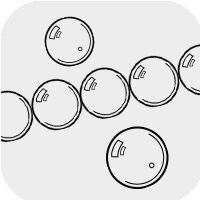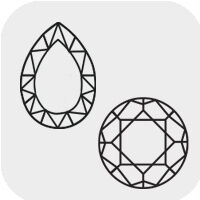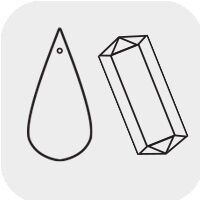Zirconia, Cubic Meaning and Properties
Cubic Zirconia History
Cubic zirconia is a lab-grown gemstone; its most popular and common use is as a diamond simulant. Developed during the 1970s in the USSR, this sparkling stone was designed for use in military application involving optics and lasers. This diamond look-alike, sometimes labeled "cubic zirconium" (an inaccurate nickname), soon took the world by storm.
The name itself is a contradiction. Zirconium is a metal that, in its crystal form, becomes the tetragonal gemstone zircon. Zircon itself is a zirconium silicate, while our favorite diamond simulant is a zirconium oxide. Swap out the silicon for the oxygen and guess what happens? The tetragon suddenly crystalizes as cubes instead!
And cubic zirconia is born.
Cubic Zirconia Metaphysical Properties
Cubic zirconia (casually referred to as "CZ") is believed to exhibit some of the same metaphysical properties as zirconium. Zirconium oxide (the base powder used to create CZs) is abundant in lunar and asteroidal rock, as well as being a byproduct of titanium processing. Zirconium is also highly resistant to corrosion and is commonly used as alloy in artificial joints and medical implants. All of which affects the metaphysical impacts of cubic zirconia.
This stone is believed to improve focus, increase clarity and release the ego. Called "the stone of practicality," some practitioners use it for grounding. While some users apply cubic zirconia to remove illusion and drain selfishness, others allege that the stone doesn't have any energy at all!
Cubic zirconia is a diamond simulant and has been assigned to April and the zodiac signs Aries and Taurus. It has been used with the third eye, crown and solar plexus chakras.
Cubic Zirconia Geological Properties
Cubic zirconia has to be manufactured. Ironically, much like the diamond it simulates, cubic zirconia is most affected by itself. To turn a zirconium silicate into a zirconium dioxide requires high levels of heat. Most are made in an industrial-level microwave, which heat from the inside outward, so the outer layer of material is the container for the melted interior--rather like leftovers, cool around the edges and hot at the center. This is charmingly referred to as a "skull melt."
Cubic zirconia is a fine thermal insulator while diamond is a thermal conductor. Light dispersion is noticeably higher in CZs. In addition, cubic zirconia differs significantly from diamond in a number of other categories, including 3 of the 4 Cs: Color, Clarity and Carat:
- Color: Cubic zirconia is typically colorless or clear, though adding a range of standardized colors is becoming easier and easier. CZs are now available in almost every color imaginable, with trace mineral impurities added to create colors. Red, orange and yellow are made with cerium, while chromium makes green and titanium creates golden brown stones. Some manufacturers also add a metal oxide film to some gems, giving them an iridescent effect--often marketed as the "mystic" finish.
- Clarity: While diamonds have natural inclusions, CZs are nearly flawless (FL to IF clarity, in diamond terms). This aids in light refraction, making them sometimes brighter and more sparkling than equivalent diamonds. The recent addition of DLC film (Diamond-Like Carbon) to some cubic zirconia stones calms the extra sparkle, making them even closer visually to diamonds.
- Carat: Cubic zirconia weighs approximately 1.7 times more than a diamond of the same size. This is one reason why they are typically measured using millimeters instead of carats.
Cubic zirconia is cut into a range of bead and gem shapes. Most faceted gem shapes follow those for precious stones (like diamond), with a pavilion, crown, girdle and table. The edges may be slightly rounded in comparison to a diamond's.
|
|
|
|
|
|
|
|
|
|
|
|
|
|
5.5 - 6.0 |
|
|
|
Proper Care of Cubic Zirconia
Cubic zirconia can get dirty and dull easily--all that sparkle picks up dust! The best way to clean CZs is to use a small soft brush and hot water. Soap may not be necessary at all. Rinse with warm water and pat dry with a clean cloth. This stone is fairly durable and can be cleaned with most sonic and steam devices.
If the cubic zirconia is in a metal setting, clean the piece to the needs of the metal setting. Plated items need to be treated with care so the plating is not scratched or damaged. If the cubic zirconia is strung, clean by hand and avoid immersing or soaking, to prevent damage to the thread or beading wire.
To learn more about cubic zirconia and other gemstones, order your copy of Walter Schumann's revised and expanded edition of Gemstones of the World.
Designing with Cubic Zirconia
Cubic zirconia is a durable stone that adds sparkle and shine to any design. Since it also comes in a range of colors, it can be used anywhere you want to attract light. While you'll find a number of cubic zirconia rhinestones set into earring findings and clasps, they can also be strung next to gemstones to highlight their color. For example, put two purple cubic zirconia drops on either side of a larger amethyst focal to add light play around it. Being bracketed by sparkle helps draw the eye--and the light--to the focal component.
View more resources featuring cubic zirconia, including Design Ideas, Videos, Tutorials and more!
Shop for Cubic Zirconia
**Please note that all metaphysical or healing properties listed are collected from various sources. This information is offered as a service and not meant to treat medical conditions. Fire Mountain Gems and Beads® does not guarantee the validity of any of these statements.
How did you like this resource? Your feedback helps us provide resources that matter to you most.
Copyright Permissions
All works of authorship (articles, videos, tutorials and other creative works) are from the Fire Mountain Gems and Beads® Collection, and permission to copy is granted for non-commercial educational purposes only. All other reproduction requires written permission. For more information, please email copyrightpermission@firemtn.com.



